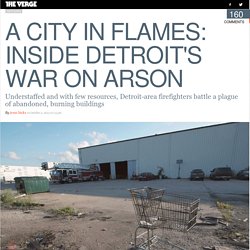

A city in flames: inside Detroit's war on arson. For eight long years, the firefighters of Highland Park, Michigan, worked out of a warehouse.

There was no red-bricked facade, no lanky Dalmatian. No freshly washed engines gleaming in the sun. No second-floor fire pole to descend in the dead of night to wailing sirens. Whatever idealized vision you have of firefighting, Highland Park is not it. Instead, picture a hulking, boxy building on the edge of an industrial park about six miles north of downtown Detroit. The Highland Park fire department opened nearly a century ago, in 1917, to serve the booming city. "We do stuff kind of old-schoolish, because that’s what we have: old-school, crap equipment," says Scott Ziegler, a first-generation fireman who’s worked in Highland Park for four years.
Highland Park is three square miles surrounded by the city of Detroit, and shares the litany of woes affecting the area. "We’ve pulled up to stuff we just couldn’t control. " 19 shocking facts about Detroit's bankruptcy. Anatomy of Detroit’s Decline - Interactive Feature. Mayor Coleman A. Young of Detroit at an event in 1980. Richard Sheinwald/Associated Press The financial crisis facing Detroit was decades in the making, caused in part by a trail of missteps, suspected corruption and inaction.
Here is a sampling of some city leaders who trimmed too little, too late and, rather than tackling problems head on, hoped that deep-rooted structural problems would turn out to be cyclical downturns. Charles E. Edward Jeffries, who served as mayor from 1940 to 1948, developed the Detroit Plan, which involved razing 100 blighted acres and preparing the land for redevelopment.
Motor City: The Story of Detroit. The 8 Mile Road Divide: Detroit's Bankruptcy and its Wealthy Neighbour. In the 2000 U.S.

Census, Oakland County, Michigan, was by one measure the fourth-wealthiest in the U.S.; although the county slipped somewhat in 2010, Bloomfield Hills – its most prosperous section – remains one of the most affluent half a dozen suburbs in America. This is the terrain of exclusive country clubs and private academies, where the multi-millionaire presidential candidate Mitt Romney went to school, and banks advertise openings for ‘Wealth Relationship Associates.’ Cross its southern border – the 8 Mile Road – and you enter Detroit, which yesterday became the largest ever U.S. city to file for bankruptcy. With debts of $15bn, 70,000 abandoned properties, and well over a third of its residents living below the poverty-line, the Motor City stands in stark juxtaposition to its well-heeled next door neighbour. Detroit’s fall is well known. But as well as plotting Detroit’s fall through time we should also do so through space. Detroit’s Bankruptcy Reflects a History of Racism. This is black history month.
It is also the month that the Emergency Manager who took political power and control from the mostly African American residents of Detroit has presented his plan to bring the city out of the bankruptcy he steered it into. This is black history in the making, and I hope the nation will pay attention to who wins and who loses from the Emergency Manager’s plan. Black people are by far the largest racial or ethnic population in Detroit, which has the highest percentage of black residents of any American city with a population over 100,000.
Eighty-three percent of the city’s 701,000 residents are black. It continues to be an underreported story that a white state legislature and white governor took over the city and forced it to file for bankruptcy against the will of its elected representatives. It’s important to view what is happening to Detroit and its public employees through a racial lens. Government was involved at a more micro level as well. Detroit bankruptcy renews fears that the city may sell masterpieces from the Detroit Institute of Arts. View full sizeThe Detroit Institute of Arts has been financially embattled for decades.

The city's bankruptcy on Thursday poses a new threat, according to numerous reports.Thomas Ondrey, Plain Dealer file When Detroit declared bankruptcy on Thursday, it raised alarms over the future of one of the nation’s finest art museums: the Detroit Institute of Arts. The Detroit Free Press reported in May that Kevyn Orr, appointed in March by Michigan Gov. Rick Snyder as Detroit’s emergency manager, said he might sell works from the city-owned museum’s collection to help avert a municipal financial crisis. In June, the paper followed up by reporting that "creditors could pressure Orr to sell art or push the DIA to contribute revenue" to the city. Whether Orr has the legal authority to sell works by Vincent Van Gogh, Paul Cezanne or Henri Matisse is unclear, but the museum felt the need Thursday to reiterate its position that the collection is held as a public trust, and cannot be sold.
“I’m sure Mr. The two Detroits: a city both collapsing and gentrifying at the same time. James Cadariu was born and bred in a neighbourhood that’s now falling to pieces.

In the late 1980s, Cadariu’s mother and brother were held up at gunpoint in the east side of Detroit. They fled for the suburbs, part of the massive “white flight” that helped turn Detroit from a bustling city of two million into a city of under 700,000. Those who stuck it out became unwilling icons of the supposed decline of the American empire, the subject of a thousand news articles, documentaries and books. Cadariu, now 44, was sick of seeing his city like that. So he came back. Business & Financial News, Breaking US & International News. Detroit bankruptcy: A master time line.
Key dates and developments in Detroit's historic trip through Chapter 9 bankruptcy.

January: Gov. Rick Snyder takes office, begins discussing Detroit's financial distress with New York-based investment banker and Detroit native Ken Buckfire. Dec. 21: Treasurer Andy Dillon delivers assessment that the city is in state of "probable financial distress," a prerequisite to appointment of an emergency manager. Dec. 27: Snyder appoints 10 members to a review team to assess Detroit's finances. March 26: Financial review team says Detroit is in severe financial distress. April 4: Detroit City Council signs a consent agreement with the state, agrees to overhaul finances and government to avoid insolvency. Nov. 5: Voters repeal emergency manager law, Public Act 4. Dec. 13: State Legislature approves a replacement for the EM law — with a few revisions — called Public Act 436, the Local Financial Stability and Choice Act.
Timeline: Detroit’s road through bankruptcy. March: Michigan's Public Act 4 emergency manager law takes effect, giving state-appointed overseers of financially troubled cities the power to tear up contracts and make other unilateral moves usually reserved for locally elected officials.

November: Detroit Mayor Dave Bing says the city could run out of cash by April 2012 and have a shortfall of $45 million by June 30. December: State Treasurer Andy Dillon orders a preliminary financial review of Detroit, announces the city is in "probable financial stress" and recommends Gov. Rick Snyder send a team to review city finances. January: Dillon gives Bing until February to submit a financial plan to avoid an emergency manager.